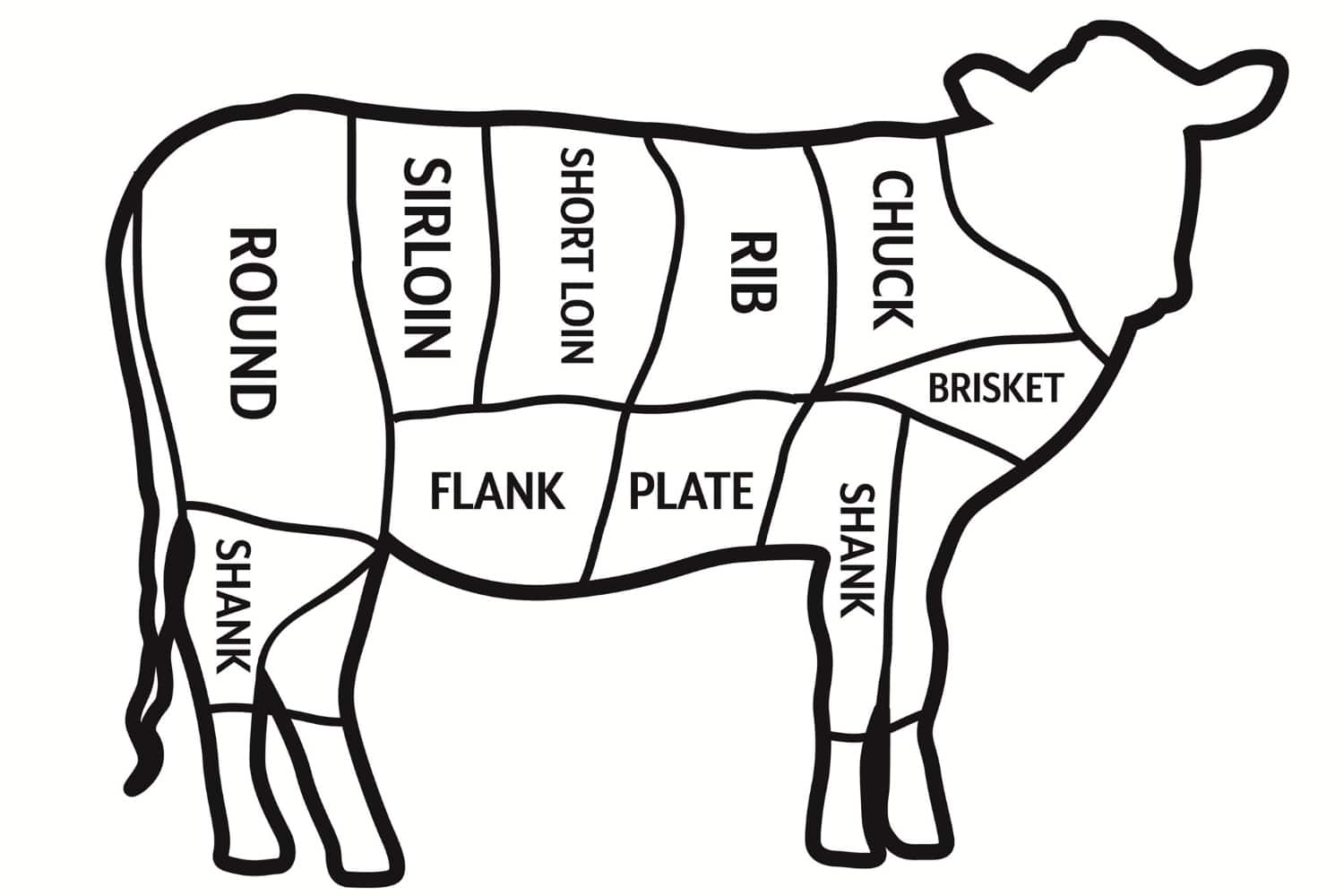Decisions, decisions.


There’s no denying that summer is the season for grilling. And when it comes to grilling, beef takes center stage.
From juicy steaks to sizzling fajitas, beef has a place in a wide range of dishes. However, not all cuts of beef are created equal. Each cut has its own unique characteristics, flavors and ideal cooking methods.
In this guide, explore the top eight different cuts of beef, learn how they’re best cooked and even discover a few recipes to make the most of each one.
Hungry for more? Take one of our cooking classes! From eats inspired by the hillsides of Tuscany to good ol’ down-home American favorites, you’ll learn inside tips and tricks from our resident chefs.
Different cuts of beef can vary significantly in terms of texture and flavor—and even the cooking methods in which you prepare them.
Texture: The texture of a cut of beef is influenced by the amount of connective tissue, fat content and muscle fibers present in the meat. Cuts with more connective tissue tend to be tougher, requiring longer cooking times to break down the collagen and become tender. On the other hand, cuts with less connective tissue are typically more tender and have a smoother texture.
Flavor: The flavor of beef can also differ depending on the cut. The level of marbling (intramuscular fat) within the meat contributes to both its flavor and juiciness. Cuts with higher marbling, such as ribeye or striploin, have a rich, buttery flavor because of well-distributed fat. On the other hand, leaner cuts—like tenderloin or sirloin—have a milder taste. Additionally, different muscles within the animal can have distinct flavors. Muscles that are more actively used, such as those from the shoulder or leg, tend to have a stronger, beefier flavor compared to muscles that are less active, like those from the loin or rib area.
Cooking methods: How you cook beef also plays a role in influencing its texture and flavor. Slow-cooking methods like braising or smoking can transform tougher cuts into tender, melt-in-your-mouth dishes, while high-heat methods like grilling can enhance the natural flavors and create a caramelized crust, adding greater depth to the cut of beef.

Known for its exceptional marbling, the ribeye is a favorite among steak enthusiasts. This cut comes from the rib section and offers a rich, buttery flavor. It is best cooked with a high-heat method, such as grilling or searing, to bring out its juicy tenderness.
A reverse-sear method is also a great choice for cooking a ribeye (particularly if it’s a thicker ribeye). To reverse sear a steak, you’ll typically start by slow cooking the meat at a low temperature first—usually in a cast iron skillet in the oven—and then finish it with a high-heat sear, either on the stovetop or on the grill.
Ribeye recipes to try:
The tenderloin is, as the name implies, the most tender cut of beef—highly valued for its melt-in-your-mouth texture and mild flavor. Filet mignon is cut from the tenderloin, a muscle that sits beneath the backbone and runs along the spine. This muscle is not heavily exercised, which means it has less connective tissue and is naturally more tender compared to muscles that are more active.
Tenderloin doesn’t have a ton of marbling—and while fat contributes to flavor and juiciness, excessive fat can also affect tenderness. With less fat in filet mignon, the meat tends to have a smoother, softer texture. The muscle fibers in filet mignon are also fine and tightly packed, resulting in a more tender texture. The compact arrangement of muscle fibers contributes to the tenderness and delicate mouthfeel of the meat.
One of the best ways to cook filet mignon is to simply season it with salt and pepper, sear it on high heat and finish it in the oven to achieve a perfectly tender and juicy result. For a simple, no-fuss recipe, try making this Cast Iron Seared Steak (video instructions included).
Tenderloin recipes to try:
Sometimes called New York strip or sirloin, striploin is a popular and highly regarded cut of beef known for its exceptional flavor and tenderness. Cut from the striploin section, which is adjacent to the sirloin, New York strip steak offers a perfect balance of marbling and meatiness. Its rich marbling ensures a succulent and juicy eating experience, while its fine texture contributes to its overall tenderness.
Renowned for its robust, beefy taste, New York strip steak is often favored by steak enthusiasts. It boasts a pronounced flavor that is further enhanced when cooked using high-heat methods such as grilling or broiling. The exterior of the steak develops a delicious char and crust, while the interior remains juicy and tender.
Striploin recipes to try:
The sirloin is a versatile cut that comes from the upper part of the rear back. It is divided into top sirloin and bottom sirloin.
The top sirloin, with its fine texture and marbling, is particularly tender and boasts a deliciously beefy taste. It is often enjoyed as steaks that can be grilled, broiled or roasted to perfection. The bottom sirloin, while slightly less tender, still delivers on flavor and is frequently utilized in dishes such as roasts or braised preparations. With its versatility and robust taste, sirloin is a favorite among meat lovers.
One of the advantages of sirloin is its affordability without compromising on quality or taste. Whether it’s a succulent top sirloin steak served with grilled vegetables or a slow-roasted bottom sirloin roast infused with aromatic herbs and spices, the sirloin lends itself well to a range of culinary creations. Its versatility allows for various cooking techniques, making it a popular choice for backyard barbecues, elegant dinners and everyday meals.
Sirloin recipes to try:
Brisket is a cherished and flavorful cut of beef that has become synonymous with traditional barbecue. It comes from the chest area of the cow, specifically the breast or lower chest region. Known for its generous marbling and connective tissue, brisket requires long, slow-cooking methods to transform it into a tender and succulent masterpiece.
The key to unlocking the full potential of a brisket lies in low and slow cooking. Typically, it is prepared by smoking or braising in a Dutch oven, which allows the collagen in the connective tissues to break down slowly, resulting in a tender and moist final product.
The process can take several hours, often exceeding 8 to 12 hours, but the result is well worth it. The smoky aroma, flavorful bark and melt-in-your-mouth texture of a properly cooked brisket make it a true culinary experience for barbecue enthusiasts and meat lovers alike.
Brisket is versatile and can be served in various ways. It is often sliced across the grain into thin, tender slices and served as a main course. It can also be chopped or shredded for use in sandwiches, tacos, or as a flavorful addition to other dishes. The versatility, robust flavor and tender texture of brisket make it a centerpiece for gatherings and special occasions, creating a memorable and satisfying dining experience.
Brisket recipes to try:
Chuck comes from the shoulder region and is a flavorful and economical cut. It contains connective tissue and fat which contribute to its flavor and make it ideal for slow-cooking methods, like braising or stewing. Chuck is commonly used for pot roasts and can result in tender, succulent meat when cooked properly.
When grilling, it’s also popularly used for “poor man’s burnt ends.” For poor man’s burnt ends, the chuck roast is cooked low and slow, similar to traditional burnt ends, until it becomes tender and can be easily pulled apart. The meat is then cubed and tossed in a flavorful barbecue sauce, returning it to the smoker or oven to develop a sticky, caramelized exterior.
Chuck roast recipes to try:
Short ribs are a popular choice for meat lovers seeking rich, beefy flavors. These ribs are taken from the lower rib section of the cow and have a generous amount of marbling. They are great for braising or slow cooking, resulting in tender, fall-off-the-bone meat.
The beauty of short ribs lies in their ability to transform into melt-in-your-mouth perfection when cooked low and slow. The long cooking time allows the collagen in the connective tissues to break down, making the meat ultra-tender. Whether braised in a savory sauce, cooked in a slow cooker, or smoked to perfection, short ribs reward patience with a truly satisfying and indulgent dining experience.
They are often served as a main course alongside hearty sides or incorporated into dishes like stews, soups or ragù. You may also find them labeled as kalbi short ribs, which are a variation of beef short ribs but cut across the bone into thin slices, allowing for faster and more even cooking. The term “kalbi” refers to the specific marinade and grilling style used for these short ribs in Korean cuisine. The marinade gives the meat its distinct flavor, and the grilling or barbecuing method adds a delicious charred and caramelized exterior.
Short Ribs recipes to try:
Flank steak is a prized cut of beef known for its rich flavor and versatility. It comes from the abdominal area of the cow and is distinguished by its long, flat shape and prominent grain. Its bold, beefy taste is complemented by its slightly firmer texture—which, when cooked properly and sliced against the grain, becomes tender.
One of the key attributes of flank steak is its versatility in the kitchen. It lends itself well to various cooking methods, making it a go-to choice for many dishes. Whether marinated and grilled to perfection, quickly seared in a stir-fry, or broiled to create flavorful steak tacos, flank steak adapts beautifully to different flavor profiles and cuisines. Its thinness makes it ideal for dishes that require a quick cooking time, allowing for delicious and convenient meals.
Flank steak’s rich flavor—coupled with its ability to absorb marinades and spices—makes it a favorite among home cooks and chefs alike. It is often used in popular dishes like fajitas, carne asada and Korean bulgogi.
Flank steak recipes to try:
Understanding the different cuts of beef allows you to select the perfect cut for your desired dish and cooking method—and finding your favorite grilling favorite! Experiment with different cuts, cooking techniques and flavors to create your own culinary masterpieces with beef as the star ingredient.
Hungry for more? Take one of our cooking classes! From eats inspired by the hillsides of Tuscany to good ol’ down-home American favorites, you’ll learn inside tips and tricks from our resident chefs.
JOIN THE CONVERSATION